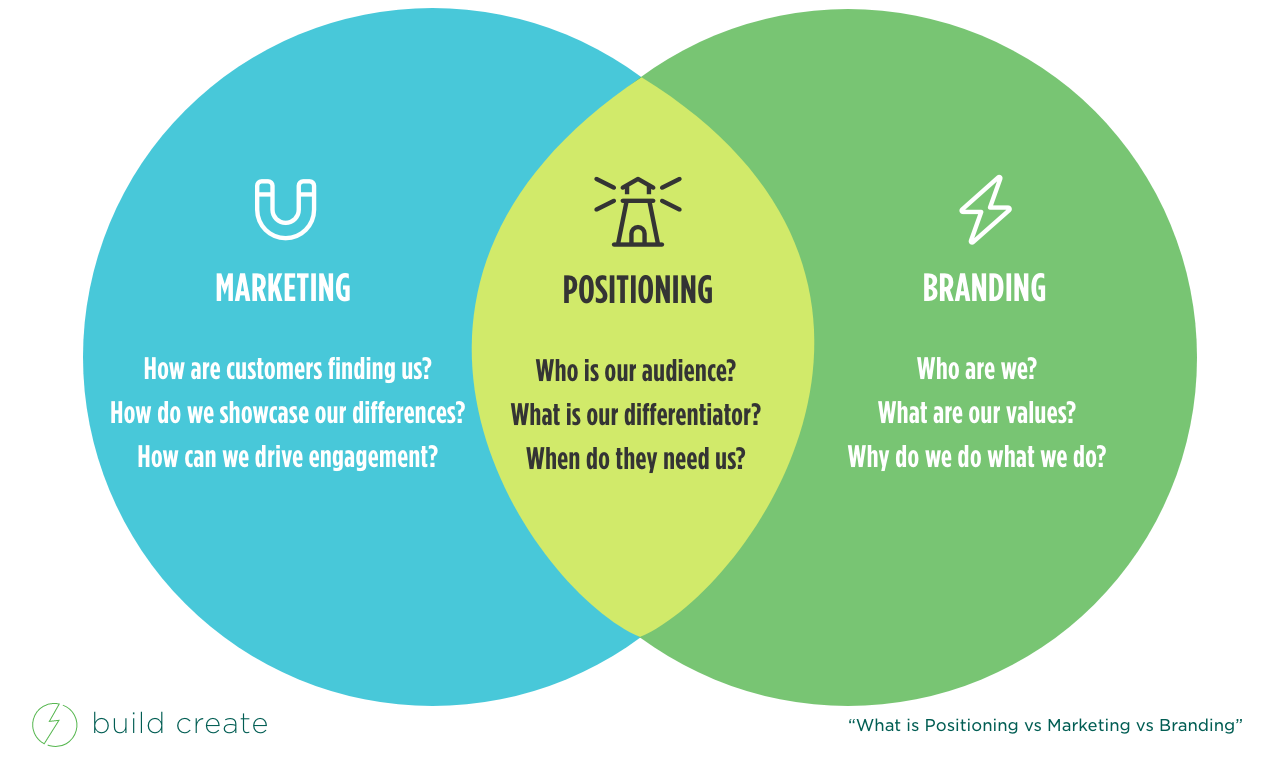Positioning exists at the intersection of Marketing and Branding.
As marketing leaders we’ve all read an overwhelming number of articles about marketing and branding, usually as separate pieces. They come with titles like “Lessons from top brands” or “Marketing trends for this year,” touching on topical concerns or common faux pas. Positioning on the other hand doesn’t roll off the tongue quite as well, but it’s a fundamental aspect of both marketing and branding.
Positioning answers three key questions: what is your niche, who is your audience, and how are you different? The goal of positioning work is to make your brand top of mind for your right-fit customers.
This is where the practical realities of business (pricing, distribution, market share) intersect with the identity of the company, and how you show up in the world and attract customers. When you go through the process of positioning or repositioning in support of a larger branding and marketing strategy, you’ll find that most of the answers you seek are close at hand in your colleagues and coworkers.
Your unique and shared experiences are ultimately the beating heart of your brand, and the insights into what’s working and what’s not are priceless.
To understand the interplay between branding, marketing, and positioning, let’s look at each of these pieces in turn. I’ve included discovery questions for each which you can use as an exercise to help you explore where your own business stands in each of these fundamental aspects of brand communication.

Branding is about being the kind of business you’d want to work with: communicative, effective, and authentic.
Branding and Positioning are symbiotic: when one is executed poorly, both suffer. If they’re out of alignment, customers show up expecting one thing, and you give them something different. And before we go any further, “Trustworthy” and “Reliable” are not an identity, value, or purpose—they are aspirations. They’re how we want to be perceived as the result of our identity, with actions driven by our values, executed with a sense of purpose.
These are the key questions to getting branding back on track:
Who are we?
What is your history? Is it a family-owned business? Is it an employee-owned business? What words come to mind when you think of the company? Which staff member(s) best represent how we want to be perceived? Examples could include, “We’re the hero that swoops in to save the day,” or “We’re your behind-the-scenes support,” which can represent two distinct personalities.
What are our values?
What key principles inform decision making within the company? Are there any social issues that the company aligns with? A company who values its employees’ well-being may have higher prices to facilitate offering better benefits, or a company competing at a lower price point may value being accessible to a certain audience. A company’s values are present in how it does business, no matter what their website says.
Why do we do what we do?
We all find ways to make meaning and derive fulfillment from some aspect(s) of our work, even if it doesn’t seem like it on the surface. It can be as simple as “Doing great work with people we enjoy working with,” or “Delivering product at a price point that is more accessible to an underserved audience.” One manufacturing executive we spoke with said that the company exists to create opportunities and abundance for their employees. That’s pretty powerful clarity.

Marketing is where the rubber meets the road and all of the work you’ve done branding and positioning yourself is put to the test by your audience.
We’ve all had to try to create a marketing strategy and tactics for brands that are less than their best. It’s part of the job, but it doesn’t have to be the norm. By understanding the synergy between positioning, marketing, and branding, you can do a lot more with a lot less by shifting what you have closer to alignment.
Another important consideration is that not all marketing is sales driven. In our post-COVID world, manufacturing companies often struggle with staffing churn, in which case replace “customer” with “talent”.
Some marketing questions that build upon your positioning and branding are:
How are our customers finding us?
In manufacturing, this is not usually Google. Trade shows, LinkedIn, and professional referrals are much more fertile ground to grow new client relationships. If you know your potential customers are listening to certain industry podcasts, get a guest spot! For talent acquisition, are they able to apply through your website, or are you working exclusively with recruiters and temp agencies? Do the employees you need use LinkedIn, or are they earlier in their career and more likely to be found on Facebook, Instagram, or other social media?
How do we showcase our differences?
Case studies are a brilliant first step to illustrating in detail how you work, and give you a wide open canvas to show your competitive advantage in action. Refer back to your branding and positioning work (more on that next) and ask yourself, “How does this project show our values in action?” and go from there. The content you share on your company blog or LinkedIn reflects your brand identity, which will shine a light on your differentiating factors.
How can we drive engagement?
The first rule of driving engagement is that it’s not about you. The second rule is, be helpful, or at least useful. It’s a conversation, usually about your audience, or something they care about. Look back at the positioning question “When do they need us?” and speak to that. Your audience needs to know that you not only know their struggles, but that you care and have insight. That can take the form of articles, video, social posts, or even a survey.

Positioning requires you to dig deep to find a unique place for your brand in your customers’ minds.
Let’s bring this all together by talking about positioning itself. Brand positioning asks fundamental questions that lay the groundwork for your branding and marketing efforts. Having thoughtful, well-researched answers to these questions is the first step in achieving focus, clarity, and purpose in your marketing. Emphasis on “thoughtful” and “well-researched.” In order to move the needle, you need to dig deeper for the answers.
Positioning questions look like:
Who is our audience?
As an established business, you already know who is buying your product or service.But even more importantly, you need to understand who your right-fit clients are. Those clients that make you say, “If only every customer were like them!”—that’s who we’re talking about here. One thing that makes these clients so great is that they often align with who you are in a way that makes working together effortless.
What is our differentiator?
As marketers, I think we may all be sick of asking ourselves this question. I know I get fatigued by it. We often think of differentiators in terms of the capabilities of our product, or the expertise of our team—and those things have value, but they’re not what we’re asking right now. This is a culture question. So instead of asking yourselves, ask your office staff, ask your team leaders on the shop floor, ask your account reps, ask the C-suite: In your mind, what is the most important thing clients should know about our business?
When do they need us?
Is what you do time-sensitive, or tied to a certain stage of business or production? That can lend a powerful sense of purpose! For example, companies tend to revisit their positioning strategy when there’s restructuring, or during a crisis, i.e. staffing shortages following COVID. Knowing that context, and speaking to it, can be powerful in driving engagement with your customers because it shows you have deep awareness of their challenges.
Positioning is essential to both branding and marketing because it provides clarity around who you are, who your audience is, and how you attract and engage with them.
Your brand’s position exists in the mind of your audience—a little (or big) piece of real estate that determines how quickly you come to mind when they encounter a problem that you are positioned to solve. Branding infuses every aspect of your marketing with authenticity and consistency that customers need to see to build trust and a sense of familiarity. Marketing is where you step out into the world and follow the guiding principles you’ve laid down in your branding and positioning.
Next in our brand positioning series: When Do You Need to Focus on Brand Positioning?
